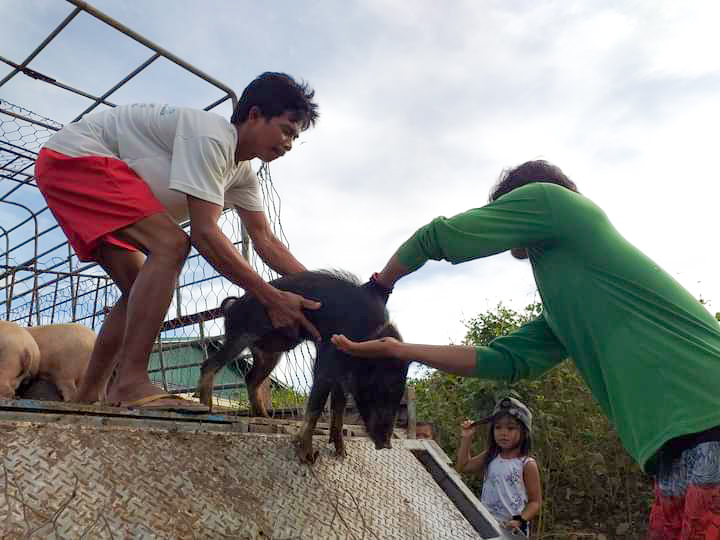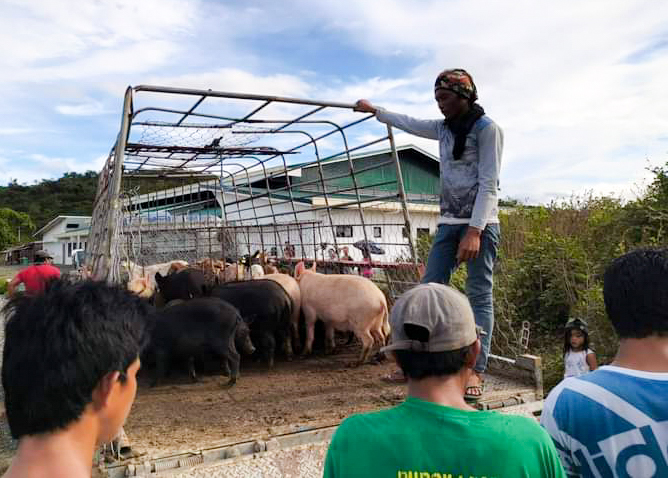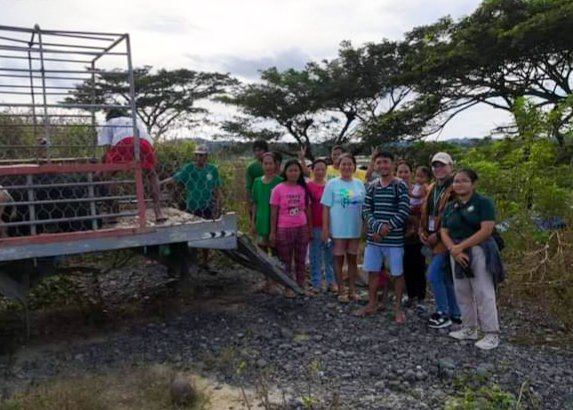OCCIDENTAL MINDORO, January 8, 2023 – Tagalog and Tau-Buhid rice farmers in Calintaan, Occidental Mindoro received pig production livelihood inputs from the Department of Agriculture – Special Area for Agricultural Development (DA-SAAD) Program under the Native Pig Production Project to diversify local agricultural livelihood in the community.
The animals are awarded to farmer-groups residing in National Task Force – End Local Communist Armed Conflict (NTF-ELCAC) identified areas.
Twenty-five (25) Tagalog farmers from the Samahang Magsasaka para sa Kaunlaran ng Sitio Looban (SaMaKaSiLo) located in Brgy. Tanyag were awarded with 24 native pigs which will be raised in a 100 square meter (sqm) communal pig pen in their barangay.
Meanwhile, in Brgy. Poypoy, the Tupos Diversified Organic Farmers Association (TDOFA) with 25 Indigenous People (IP) beneficiaries received 37 native pigs which will be sustained through the implementation of a roll-over scheme. Each member received one (1) native pig to raise, and the excess 12 will be placed in a communal pig pen located in a member’s area. Group members will take turns taking care of the native pigs.
While Occidental Mindoro remains African Swine Fever (ASF)-free according to the Bureau of Animal Industry, the animals will be quarantined for at least seven (7) days in the barangay facilities as an added preventive measure before turnover. Additionally, each group received five (5) liters of vitamins under the same project to ensure that the animals will be in their ideal health condition.
According to Mr. Cyrus James Alejandro, chairperson of SaMaKaSiLo, being mainly engaged in rice farming, group members would usually invest their extra income in livestock-raising for a guaranteed profit as it is manageable to maintain, with a stable and sure market.
“Kadalasan kapag may extrang pera, nilalaan talaga sa pag-aalaga ng baboy kasi safety ‘yung pera tapos tutubo ka rin kapag naibenta na” (Whenever there’s money to spare, we often allot it in swine raising because it secures our money and guarantees profit), Mr. Alejandro said.
Beneficiaries, especially the IP farmers of TDOFA belonging to the Tau-Buhid tribe, shared that native pig-raising is more ideal for them as it is less expensive compared to hypor breed of pig.
“Mahirap para sa amin na mag-alaga ng hypor na baboy kasi kailangang [pellet] feeds ang ipakain na may kamahalan. Di kagaya ng native na baboy kasi pwede mong pakainin lang ng mga kangkong, katawan ng saging, mga tirang gulay” (It is difficult for us to raise hypor pigs because they feed on pellet feeds which are expensive. Unlike native pig who feeds on vegetables), Mr. Ramon Magsaysay Jr., a member of SaMaKaSiLo shared.
Native pig’s meat prices range from Php 300.00 to Php 350.00 per kilo in the municipality. This is higher than hypor breed’s prices valued between Php 250.00 to 280.00 per kilo.
Farmers of SaMaKaSiLo and TDOFA groups were organized by SAAD with the assistance of the Municipal Agriculture Office (MAO) along with other SAAD beneficiaries, living in ELCAC areas in other municipalities.
Calintaan Municipal Agriculturist Nelia Oreiro reminded the beneficiaries to focus their efforts on reproduction to sustain their project.
According to Mr. Jerald M. Ladringan, Cooperative Development Officer II of the MAO of Calintaan, they plan to conduct a capability-building activity for the beneficiaries in April 2023 to further assist the farmers in expanding and improving their conventional knowledge in native pig-raising. ###
Writer: Dianne Francis A. Sy-Gorembalem, SAAD MIMAROPA Information Officer
Sources: Jercel N. Catubig, SAAD Area Coordinator – San Jose,
Relan S. Sabac, SAAD Area Coordinator – Calintaan
ASFZone Update as of November 02, 2022. Bureau of Animal Industry, Bantay ASF sa Barangay “BABay ASF”. Retrieved from: https://www.facebook.com/100067437784044/posts/pfbid02L2WowXkbojg8sZqmyjUuLspZxNFrruhXCFEuqcUs9pWbuYuJryihYSY95Fq5jzSTl/?mibextid=Nif5oz.




Comments (0)